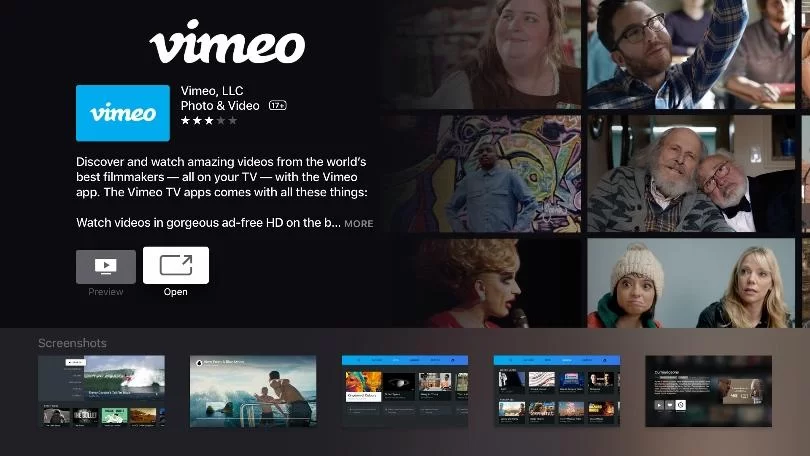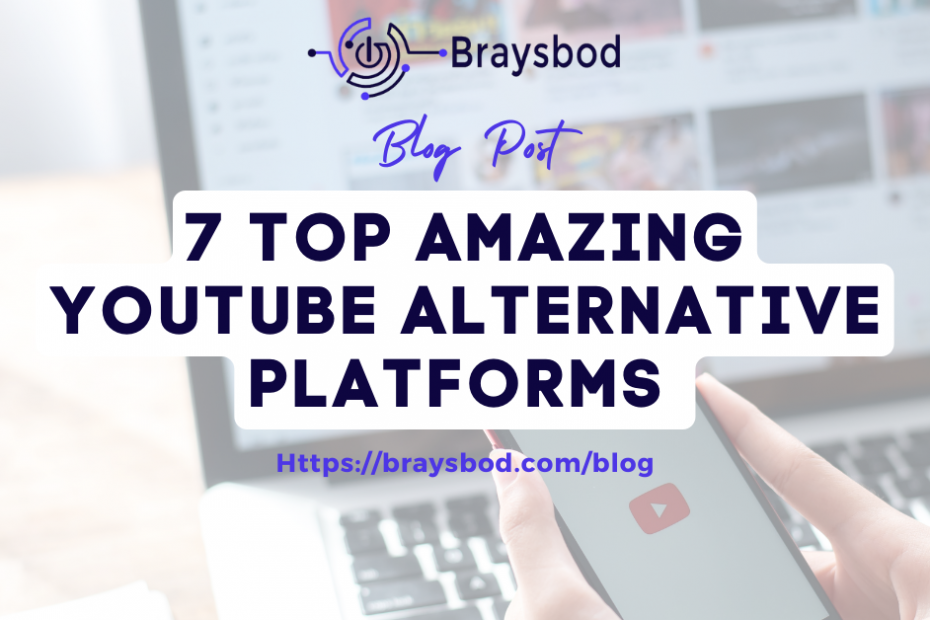It is undebatable that the 2005 launched site, YouTube is the biggest video site in the world. It is the second most visited website in the world with over two billion monthly logged users. However whether users of YouTube are completely satisfied with its framework, its terms and conditions are still left to be seen.
So today, we will be taking you down the road to meet seven other alternatives to YouTube, these alternatives might come in handy as time goes on for content upload, online streaming, and any other activity that can be carried out on video sites.
1. Vimeo

Vimeo remains one of YouTube alternatives biggest competitors and has quite a decent number of users. It was launched and over years had gained great popularity among video sites.
For one, it gives users the opportunity of connecting and interacts with other video creators. It also has an easy “to browse” feature. Videos are organized by categories and channels for easy manoeuvring. The package is completed with the staff on standby ready to help and direct users, probably newbies who are indecisive on what to watch.
Pros
- Contents uploaded on Vimeo have a luxurious appearance and that of being a high-end products.
- It is also much easier to organize videos on Vimeo than on YouTube, with the aid of features like tags and folders, and playlists, videos can easily be sorted for convenience.
- There is an open option of privacy settings for users.
- Vimeo is known for its top-notch great customer service and the availability of staff within reach.
- It has a desktop app for Mac and Windows for easy usage by users not just on their mobiles now but also on their systems.
- There is an increased storage space reaching an enormous 7TB for premium users.
- It also has a well-developed video player with drag-and-drop templates for easy video creation.
- The site can also be used to find freelancers.
Cons
- The search algorithm still leaves much to be desired. At times it does not return relevant results to what has been inputted on the search bar.
- Vimeo is not free. Unlike YouTube, users have to pay certain amounts varying from tiers of service needed for the usage of the site. However, payment plans vary, and as there are lower payment plans though with limited features.
- There is also a limitation on the number of users on a single account. For instance, there can only be a maximum of three users on a premium single account.
- Editing or replacing a video already uploaded is a very strenuous task.
- Vimeo does not make for videos to be shared externally.
- It has a basic 500MB weekly limit and users have to upgrade in order to upload larger units of content.
- Because of its YouTube-like features, there is a tendency to lose its originality and most users of the site tend to feel that they are merely using another version of YouTube.
Price
Users have to choose between four payment plans.
- Plus ($12 a month)
- Pro ($20 a month)
- Business ($50 a month)
- Premium ($75 a month)
2. Dailymotion

Also gaining popularity at a lightning speed is Dailymotion. This video site has YouTube-like features and trending videos can be found right there on the home page.
Pros
- Compared to YouTube, it is more flexible and has better tolerance for uploaders on the video site.
- An option of monetizing content via ads and paywalls exists on the platform.
- Because of the interface which is similar to that of YouTube, it is easier for users familiar with YouTube to use.
- High-quality content.
- Users, including beginners, can upload content up to 2GB in size and 60 minutes in length at a resolution of 1080p.
- Sign-up is free and quick with the requirement of an email address, a username, and a confirmed date of birth.
- Once an upgrade is made, features like live streaming and uploading of videos from mobiles can easily be accessed.
Cons
- Users are made to pay before videos can be shared on platforms like Facebook, YouTube, and Twitter.
- Dailymotion does not offer users the option of creating content, a user can only host videos that were made somewhere else.
- It tends to be clunkier and slower than YouTube.
Price
- Free
3. TikTok

With 800 million+ monthly active users, TikTok became quite an overnight internet sensation, becoming equally the most downloaded app globally. It has an already built-in video editor in its app consistent with Android and iOS and as such creation content is made as easy as possible.
There are also third-party applications with which users can upload directly to TikTok, these apps include PicsArts, Adobe Premiere, and others. TikTok is majorly known and best for short entertaining videos.
Pros
- TikTok offers one of the largest social media audiences in the world for free. That is to say, one can sign up and post content without paying a dime, and with over 2 billion downloads, one stands a good chance of being seen by his or her targeted audience without even paying for ads.
- It is targeted at mobile users. From the entire structure of the app, it can be found that it is intended firstly for phone users. From its micro-videos to its fifteen to sixty seconds (at most) limit for videos, TikTok is truly meant for mobile users.
- TikTok is available in 75 languages and is used in over 150 countries across the globe. That means new markets, new audiences, varieties of available languages. It almost cannot go wrong with TikTok.
- It saves time. By using TikTok, the time and resources needed to create videos can be curtailed as it does not demand high craft production videos. Creating videos on Tiktok can be as easy as an ordinary phone shot and simple as a relatable video of everyday life.
- TikTok is great for mindless binge-watching, users will not get bored with lengthy videos as on other platforms.
- Policies and terms and conditions are relaxed as compared to YouTube.
Cons
- TikTok is mostly used by teens and people in their 20s. So except a user’s content is targeted at young audiences or customers, there is certainly no guarantee that those in the older age bracket will be reached.
- There is a limitation of the format of content which can be posted. Though its video content remains the best performing on social media platforms, it does not let users post photos and texts as yet and this is a limiting factor in the options of the users.
- TikTok ads are very expensive, as expensive as top social media platforms as Facebook and Instagram even.
Price:
- Creating an account and content upload on Tiktok is free but still, ads are paid for.
- Ads run from $10 per 1000 views to other higher amounts and views as well.
4. Twitch

Owned by Amazon, this mainly hosts gaming-selected content where games being live-streamed can be watched. Still, other live videos can be found on the site like live videos from concerts and festivals. Today, Twitch is the official streaming platform for Ultra Music Festival in Miami.
Pros
- Twitch is one of the best video sites for gaming videos.
- It’s one of the best sites and the best option for live streaming.
- It offers viewers luxurious benefits like ad-free viewing and emotes.
- Users on Twitch can stream somewhere else.
- Viewers do not require to log in before accessing the site.
Cons
- Videos can be monetized like on YouTube but payouts are lesser.
- Twitch has chat rooms that are spammy.
- Succeeding in Twitch takes a long time and surely a great deal of patience.
- The crowd or audience could be insulting at times.
- Except the user is a fan of gaming, the time invested into Twitch might not be worth it.
Price:
- Twitch is free for viewers but streamers have to pay ranging from $4.99, $9.99 to $29.99 a month depending on the individual’s choice of tier.
5. IGTV

This is also known as Instagram TV. It comes with features like an option of swiping up in stories, carousel cards in the mobile application, and a notification bar on top of the app. Though videos can be done through the desktop, videos can only be browsed through the app.
To upload videos on IGTV, a channel is to be first created and a title and description added to the video. The user should also post a preview on the Instagram feed. IGTV has a 15 minutes limit for videos uploaded from mobile and 60 minutes for those uploaded from the web, also vertical videos run in the range of 9:16 and horizontal ones on 16:9.
Pros
- Videos can be watched from the comfort and ease of a smartphone.
- There is an option of uploading more short-form videos with a maximum limit of up to an hour.
- IGTV has a good revenue opportunity for users.
- It serves as a new way to reach more audiences.
- It comes with a more immersive experience.
- Presently, there are no ads on IGTV which benefit the viewer. It’s common knowledge how annoying ads can be.
- It is very much easy to use as users most times are conversant with Instagram and other related social media platforms.
- IGTV episodes can easily be uploaded to Facebook.
- Portrait mode videos can be shared on the site.
Cons
- The absence of the option of ads is not at all favourable to creators.
- Limitation to the form of videos that can be uploaded as videos lengthier than an hour long cannot be uploaded on the site.
- The viewers are only limited to watching videos on their cellphones and there is no way of enjoying videos on a bigger screen.
- IGTV lacks a detailed search function such as tags which help users get what they seek easily.
- Editing vertical videos with good production values has proved harder on IGTV.
- Only Instagram users can view videos on IGTV.
Price:
- Free
6. Metacafe

Metacafe was launched in 2003 and is one of the oldest video streaming sites in the world, even older than YouTube. It might not be as popular as the latter but surely, it has a few wins to its name.
Metacafe is such a site where short video clips, less than two minutes clips, ninety seconds to be precise are uploaded. It is a website that favours mostly short humorous clips and light-hearted videos.
Pros
- Regular users can make and upload short humorous clips.
- Metacafe also offers quick and second-point product reviews.
- Metacafe is simple, and users can find relatable content from the highlights of the world’s best surfers to how to complete a difficult level on your favourite video game.
- The browsing interface is straight forward and simple search tags like “latest”, “tending”, and “popular” exist to aid searches by users.
- No negative comment.
- Users have the option of choosing preferred playback quality.
Cons
- Lacks professionalism and is not the best site for work-related uploads.
- Unfortunately, it is focused on only limited genres.
Price:
- Free.
7. Vevo

Launched in December 2009, this video site is specifically known for hosting music videos and sharing. The catch is that Vevo is known for hosting videos for even the main record labels themselves. It features over 50,000 videos and still counting. By offering a professional service, promotes musicians with good standing and following and might not be the best option for a beginner musician or band.
Pros
- Video content uploaded on Vevo can easily be accessed on YouTube.
- Though it might not seem so, Vevo is not just for music video sharing, it also offers live performances, behind-the-scenes footage, interviews with artists, and original series.
- A user who wants to find an artist’s original music video can easily do so without being sidetracked by other users’ uploads.
- It can also track the artists on the user’s iTunes and with the ones on their library, allowing the user to create a playlist on the site containing favourite songs, bands, or artists as the case may be.
- One other advantage of Vevo over other video sites is that it streams shows and live programmings, for instance, there is a Grammy collection of Vevo complete with all the speeches, performances, and acceptance speeches from the event!
- Users of Vevo stand a greater chance of earning higher than on YouTube because of its bigger payouts. Depending on the country, users could look forward to earning an estimated amount of $0.00222 to $0.0025 per view.
- Vevo tag on brand gives it a premium look and at times can be a means of promoting your brand and as Vevo is recognized for high-quality content, your brand stands way above those who are not yet on Vevo.
- Vevo offers users the opportunity to get more exposure for their music, with features like Vevo LIFT and Vevo Presents, users can get their music added to genre-specific playlists and get discovered by more people.
Cons
- Uploading of videos cannot be made directly to the site as the administrators are fully in charge and control whatever content goes up the site.
- Presently, Vevo is not available in every country. Only in places like the US, UK, Spain, Ireland, France, Italy, Poland, New Zealand, Netherlands, and Brazil can it be accessed.
- The users have no control at all over ads that pop up when other users watch their videos.
- Censoring of videos with inappropriate content because of the company’s heavy reliance on advertising revenue.
- Inability to engage with the audience. Users would be able to see the audience’s comments but cannot “like” or even delete/hide them when inappropriate.
Price
- Vevo is free for viewers but ads might run in the act of video streaming.
